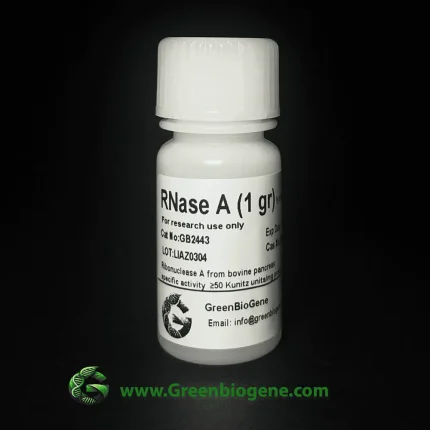Deoxyribonuclease I
⇓ Protocol
DNase I (Deoxyribonuclease I) is an enzyme that catalyzes the hydrolytic cleavage of phosphodiester bonds in DNA, resulting in the breakdown of DNA into smaller fragments. It is a versatile tool widely used in molecular biology and biotechnology for its ability to degrade DNA.
Key Features:
- Substrate Specificity:GB DNase I acts on both double-stranded and single-stranded DNA, making it highly effective in DNA digestion.
-
Optimal Conditions:
- The enzyme exhibits maximum activity at a neutral pH (around 7.0-8.0) and in the presence of divalent cations such as magnesium (Mg²⁺) and calcium (Ca²⁺).
-
Activity:
- GB DNase I generates DNA fragments with 5′-phosphate and 3′-hydroxyl termini, which are useful for various downstream applications.
Applications:
-
Eliminating Genomic DNA Contamination:
-
-
Purpose:
- Removes unwanted DNA from RNA preparations, ensuring high-purity RNA for applications such as RT-PCR and RNA sequencing.
-
Protocol:
- Add GB DNase I to the RNA sample and incubate under optimal conditions to degrade any contaminating DNA. Subsequently, inactivate the enzyme and purify the RNA.
-
-
Footprinting Assays:
-
Purpose:
- Identifies protein-DNA interactions by digesting unprotected regions of DNA while preserving bound regions.
-
Protocol:
- Treat the DNA-protein complex with GB Deoxyribonuclease I and analyze the resulting DNA fragments to determine the binding sites.
-
-
Apoptosis Studies:
-
Purpose:
- GB DNase I plays a role in the degradation of genomic DNA during apoptosis, making it useful for studying programmed cell death mechanisms.
-
Protocol:
- Detect GB DNase I activity and DNA fragmentation in cells undergoing apoptosis as a marker for cell death.
-
-
Creating DNA-Free Environments:
-
Purpose:
- Ensures DNA-free conditions in laboratory settings, particularly in PCR setups to prevent contamination.
-
Protocol:
- Treat surfaces, reagents, and equipment with GB DNase I to degrade any contaminating DNA.
-
Handling and Storage:
-
Storage:
- GB DNase I is typically stored as a lyophilized powder or in a buffered solution at -20°C. Reconstituted enzyme should be stored in aliquots to avoid repeated freeze-thaw cycles.
-
Handling:
- Use GB DNase-free reagents and maintain a sterile environment to prevent contamination.
GB DNase I is an essential enzyme in molecular biology research, offering precise and efficient DNA degradation capabilities. Its versatility and effectiveness make it invaluable for a wide range of applications, from nucleic acid purification to studying complex biological processes.





